News & Views, Volume 52 | PEGASUS: Development for TRISO Fuel and Advanced Reactor Applications
DEVELOPMENT FOR TRISO FUEL AND ADVANCED REACTOR APPLICATIONS
By: Bill Lyon
The Pegasus code allows the user to develop more realistic models of fuel behavior by utilizing an innovative 3D framework that delivers a more detailed and rigorous solution. This solution allows the user to remove conservative assumptions, simplifications, and uncertainties resulting from 2D or 1D simplified/empirical solutions.
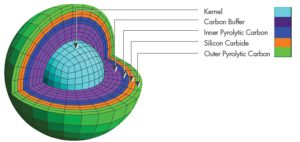
Figure 1. A PEGASUS TRISO fuel particle model and mesh showing geometry and composition
Remove the conservativism and start using the calculated operational margins to increase efficiencies and reduce the capital outlay for refueling.
QUICK FACTS
- Independently developed 3D FEM code; fuel vendor independent code provides best-estimate performance modeling
- Focused on fuel structure
- Provides high-fidelity results
- Addresses existing fuel performance
- Aids in the development of advanced fuel designs
- Ready for Gen IV Reactors and TRISO Fuels
BENEFITS REALIZED
- Reduced conservatism
- Increased efficiencies
- Potential for significant fuel cost savings
INTRODUCTION
The PEGASUS nuclear fuel behavior code is a robust 3D, finite element modeling (FEM) computational software platform capable of thermo-mechanical and structural non-linear analyses of nuclear fuel and reactor components. Focused initially on light water reactor (LWR) fuels and materials, PEGASUS is being adapted and applied to a broader range of emerging industry priorities for proposed Gen IV (Generation IV) advanced reactor designs such as high-temperature gas (HTGRs) and molten salt-cooled reactors (MSRs). These applications require modeling various fuel forms, geometries, and materials such as high assay, low enrichment uranium (HALEU), advanced cladding alloys, and other fuels with integrated containment such as tri-structural isotropic (TRISO) fuel particles and encapsulated particle fuel types. PEGASUS is perfectly positioned to evaluate these challenging structures with realistic modeling and simulation results.
TRISO-BASED FUELS AND MATERIALS DEVELOPMENT
One of the significant efforts underway in the continued development of PEGASUS is the introduction of material constitutive and behavioral models for TRISO fuel and the materials that comprise this fuel form. The initial research on the needed material property and behavior model data comes from a variety of sources, including the Department of Energy’s (DOE’s) Advanced Gas Reactor (AGR) fuel development and qualification experimental program [1] and numerous DOE-supported modeling efforts such as those from Hales et al. [2,3]. In parallel to those efforts, geometric modeling and meshing techniques specifically designed to address the complex TRISO fuel geometric configurations are being explored and developed. These exploit the CAD-like modeling environment and the already available automated meshing tools and capabilities in PEGASUS.
TRISO fuel forms are comprised of multi-layered particles embedded into fuel compacts of various compositions and shapes. The TRISO particle layers are designed to encapsulate and contain the nuclear fuel and the fission products produced during operation. It is this characteristic that creates the robust nature of TRISO-based fuels. The fuel particles are typically composed of a fuel kernel, such as uranium oxycarbide (UCO), surrounded by layers of 1) a porous carbon buffer, 2) an inner pyrolytic carbon (PyC) shell, 3) a silicon carbide (SiC) layer, and 4) an outer PyC shell. The orientation and relative thicknesses of these layers are shown in Figure 1, which depicts a basic PEGASUS TRISO particle model.
Material constitutive models have been developed for UCO fuel, porous and pyrolytic carbon, and SiC and are currently being tested for application in PEGASUS.
TRISO FUEL CONFIGURATIONS AND MODELING DEVELOPMENT
In addition to conventional FEM-based modeling and meshing capabilities, PEGASUS also contains several tools explicitly designed to facilitate advanced reactor and fuel analysis. These include: 1) a 3D and hybrid 2D/3D meshing capability to optimize computational efficiency (currently under development), 2) a “spherical mesh object” tool to generate 3D/2D spheres and embedded spheres for modeling TRISO and fully encapsulated TRISO fuel forms, and 3) a “spiral extrusion” tool which can generate complex, spiral 3D fuel geometries and meshes such as those required for helical multi-lobed advanced fuel designs.
The spherical mesh object and spiral extrusion tools are unique to PEGASUS and, to our knowledge, not found in any other fuel performance or general-purpose FEM code.
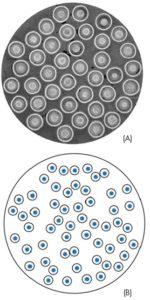
Figure 2. Example TRISO particle distribution: (a) micrograph of a TRISO fuel compact (adapted from Nelson [5]), (b) random particle distribution pattern algorithm output.
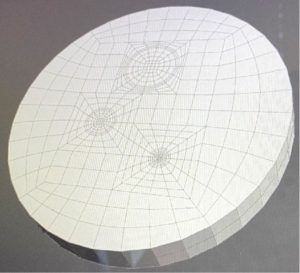
Figure 3. Cross-sectional view of embedded TRISO particles in a 3D fuel compact matrix.
These modeling capabilities allow PEGASUS to be used to investigate very detailed mechanical and structural effects in highly complex fuel forms. For example, the mechanical interaction between TRISO fuel layers, including the effects of cracking, debonding, and asphericity, can be modeled explicitly. Future work is planned to integrate damage-mechanics modeling capability into PEGASUS that is specifically applicable to TRISO-based fuels.
Given the complexity of typical TRISO fuel forms, another critical aspect for analysis is the development of a consistent methodology for generating configurations that mimic the distribution of TRISO particles in a fuel matrix. A technique has been developed based on a “passive randomization method” originated by Sukharev [4] that yields distribution patterns approximating those of TRISO fuels observed during fuel examinations. An example of an early application of this technique is shown in Figure 2, which compares a fuel micrograph to a generated TRISO particle configuration pattern.
For application in PEGASUS, geometric configurations such as shown in Figure 2b are converted into 2D and 3D FEM meshes with TRISO kernels embedded in meshed substrates using automated tools. Models such as these can provide the bases for computational studies of TRISO fuel performance, from detailed kernel multilayer response to interactions between multiple kernels and their surrounding matrix. Several examples of TRISO meshes generated with PEGASUS are shown in Figures 3, 4, and 5. Figure 3 illustrates the cross-section of a 3D TRISO fuel compact with embedded TRISO particles. The appearance of multiple particle sizes is an indication of varying particle depths within the matrix. This figure was generated using the spherical object meshing tool in PEGASUS.
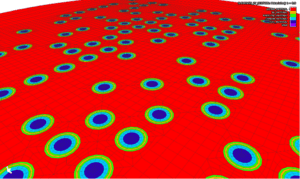
Figure 4. Cross section of an array of discrete 3D TRISO particles embedded into a graphite compact pellet.
A more complex 3D model of encapsulated TRISO particles is shown in Figure 4. This model features a sparse particle distribution generated using the randomization technique applied in Figure 2b coupled with 3D automated meshing capabilities. This model was meshed in PEGASUS using an automated scripting tool and tested early in the development project using simplified approximations of thermal and mechanical properties of the kernel and matrix materials. Boundary conditions simulating prototypic gas reactor conditions were used in the simulation. Figure 5 shows the plotted temperature distribution from a portion of the model in figure 4.
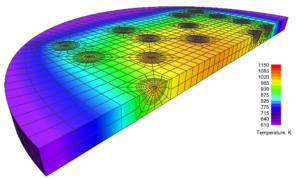
Figure 5. Temperature distribution in a cross-section of a 3D slab of a TRISO compact matrix model under prototypic gas-cooled reactor conditions.
Further development of the TRISO fuel modeling capabilities in PEGASUS is ongoing. Detailed 3D modeling of TRISO kernels with irregular geometries such as non-uniform thicknesses and shapes in the pyrolytic carbon and SiC layers has been identified as a high priority as we advance. Additional priorities for future development include 1) implementation of mechanistically based, deterministic TRISO kernel and fuel compact failure models integrated into the material constitutive relations and 2) the calculation and tracking of fission product species diffusion and concentrations which incorporate the effects of chemical interactions, kernel layer, and substrate cracking.
SUMMARY
The PEGASUS nuclear fuel behavior code is an advanced, independently developed 3D FEM computational software program capable of conducting complex, coupled thermo-mechanical and structural non-linear analyses. The role of PEGASUS is envisioned as complementary to existing regulatory-based assessment and licensing tools, where there is a need to address conservatism, perform an independent assessment, or provide additional fidelity to laboratory-sponsored research where wider materials, phenomena, or fidelity is needed. Current development activity is focused on application to proposed GEN IV advanced reactor designs featuring unique fuel materials and design configurations such as TRISO-based ceramic fuels to be deployed in HTRGs and MSRs. Future development work on PEGASUS will continue along multiple avenues, emphasizing TRISO constitutive and deterministic failure model development, implementation, and modeling. In summary, PEGASUS provides high fidelity and independent advanced analysis capability that can be used to address existing fuel performance. It allows for less conservatism and accelerates the development, design, and regulatory processes for new fuel concepts and advanced fuel designs such as those employing TRISO-based fuels.
References
- D. A. PETTI, G. BELL, and the AGR Team, “The DOE Advanced Gas Reactor (AGR) Fuel Development and Qualification Program,” INEEL/CON-04-02416, 2005 International Congress on Advances in Nuclear Power Plants, May 15-19, 2005.
- J. D. HALES et al., “Multidimensional Multiphysics simulation of TRISO particle fuel,” J. Nucl. Mat. 443 (2013) 531-543.
- J. D. HALES et al. “BISON TRISO Modeling Advancements and Validation to AGR-21 Data,” INL/EXT-20-59368, September 2020.
- A. G. SUKHAREV, Optimal strategies of the search for an extremum, U.S.S.R. Computational Mathematics and Mathematical Physics, 11(4), 1971.
- A. T. NELSON, Features that Further Performance Limits of Nuclear Fuel Fabrication: Opportunities for Additive Manufacturing of Nuclear Fuels, ORNL/SPR-2019/1183, May 2019.



